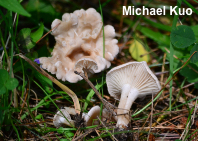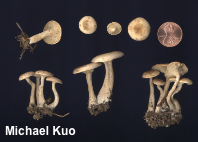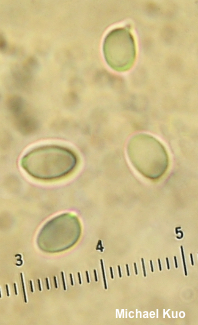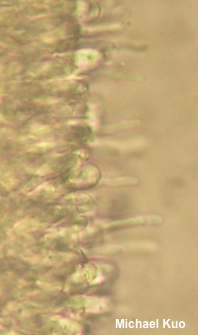| Major Groups > Gilled Mushrooms > Pale-Spored > Clitocyboid Mushrooms / Omphalinoid Mushrooms > Pseudoomphalina compressipes |

|
[Basidiomycota > Agaricales > Tricholomataceae > Pseudoomphalina . . .] Pseudoomphalina compressipes by Michael Kuo, 25 January 2023 This little litter decomposer looks like many other clitocyboid and omphalinoid mushrooms, but can be separated on the basis of its "hygrophanous" cap, which quickly fades from moist and brownish to dry and whitish; its mealy odor; its often compressed stem (see the illustration), for which the species is named; and microscopic features, including small, amyloid spores and filamentous cheilocystidia. Pseudoomphalina compressipes is part of a complex of virtually indistinguishable species best separated by their ranges, microscopic features and, ultimately, their DNA: Pseudoomphalina kalchbrenneri is a European and Asian species that lacks cheilocystidia; Pseudoomphalina intermedia is found in western North America and lacks cheilocystidia; Pseudoomphalina anticostica is a newly recognized eastern North American cryptic species that does feature cheilocystidia but may have slightly larger spores. Clitocybe compressipes is a synonym, as are Clitocybe farinacea and Clitocybe felleoides. Description: Ecology: Saprobic; growing scattered, gregariously, or in small clusters; found in grassy areas and disturbed-ground locations, or in open conifer woods; summer and fall; not common; originally described from the Albany, New York area; precise distribution uncertain (most records come from the northeastern United States and the Midwest), but apparently limited to North America east of the Great Plains. The illustrated and described collections are from Illinois and Pennsylvania. Cap: 1.5–3.5 cm; at first convex with an inrolled margin, becoming flat or centrally depressed, with an even margin; at first with a finely granular, whitish dusting, but soon bald; tacky when fresh; brownish, fading markedly to buff as it dries out; the margin not lined. Gills: Beginning to run down the stem; nearly distant; short-gills present; creamy. Stem: 2–5 cm long; 3–8 mm thick; more or less equal, but often compressed with a central vertical groove (and then up to 1 cm wide); moist when fresh; colored like the cap; bald, or with a granular-mealy apex; basal mycelium white. Flesh: Insubstantial; watery buff; not changing when sliced. Odor and Taste: Mealy. Chemical Reactions: KOH negative on cap surface. Spore Print: White. Microscopic Details: Spores 5.5–7 x 3.5–4.5 µm; ellipsoid; apiculate; smooth; weakly to moderately amyloid; hyaline in KOH. Basidia 25–32 x 4–6 µm; clavate; 4-sterigmate. Cheilocystidia 26–45 x 1.5–2.5 µm; filiform; smooth; hyaline in KOH. Pleurocystidia not found. Pileipellis a cutis of elements 2–5 µm wide, with intracellular pigment. Clamp connections present. REFERENCES: (Peck, 1883) Singer, 1962. (Murrill, 1916; Kauffman, 1918; Bigelow, 1982, 1982a; Voitk et al., 2020.) Herb. Kuo 10010502, 07211407. This site contains no information about the edibility or toxicity of mushrooms. |
© MushroomExpert.Com |
|
Cite this page as: Kuo, M. (2023, January). Pseudoomphalina compressipes. Retrieved from the MushroomExpert.Com Web site: http://www.mushroomexpert.com/pseudoomphalina_compressipes.html |



